
Tracing innovation in manufacturing Spotlight on patent innovation investments in manufacturing
8 minute read
09 July 2019
Business leaders should look beyond immediate wins and align R&D—and hence innovation—efforts with long-term strategic goals to become frontrunners in innovation.
Manufacturing drives global economies, supports the output of many other associated industries, and fosters infrastructure spending as well as job creation. To maintain steam, manufacturers should continue to identify and capitalize on new inventions and advancements. One way in which industrial companies mark their inventions is through patent filings. Patents are legal instruments used to protect inventions, and they essentially protect these inventions by giving the patent owner the right to exclude others from making, using, or selling the patented invention, typically for a period of 20 years.1
Learn more
View the Innovation in industrial manufacturing collection
For an interactive figure of patent activities related to products and processes, click here
Subscribe to receive related content
Download the Deloitte Insights and Dow Jones app
For more than 50 years, patent data has been used to proxy innovation output.2 If we scan the industrial manufacturing industry’s research and development (R&D) expenditures, we discover important nuances of the relationship between research investments and the pace and intensity of patent filings over the past decade. These connections can yield many insights for manufacturing leaders as they make R&D expenditures for patent-related innovation, some of which are:
Recognize and appreciate the pace of patent-related innovation and the potential effects of static R&D budgets on the company’s long-term performance, and change the R&D lens accordingly.
Consider the “sweet spot” this study has identified for R&D investments that yields the greatest intensity of patent innovation for a company.
Identify ways in which patent innovation related to both products and processes can yield business results.
About this research
This study is part of the broader initiative to understand and learn how exponential technologies are transforming the future of manufacturing and how global industrial manufacturing companies can best tap into this disruptive shift. Deloitte’s earlier research, Exponential technologies in manufacturing”3 explored how exponential technologies are enabling change at an accelerating pace, facilitated by substantial progress (performance improvement and cost reduction) in areas such as computing power, bandwidth, and data storage. In this study, we explore not just the pace of patent-based innovation and its relation to financial investments, but also the focus areas for industrial manufacturers during the past decade. We use data related to patents granted by the United States Patent and Trademark Office during the 2006–2018 period as a proxy for a set of 43 Fortune 100 industrial manufacturing companies.
R&D expenditures: Manufacturing lags
Manufacturing contributed more than 11 percent of the US Gross Domestic Product (GDP) during the last five years. Considering the commonly accepted economic multiplier effect of 1.82, the manufacturing industry’s contribution becomes even more significant, accounting directly and indirectly for almost 30 percent of the US GDP in 2018.4 Despite its important role in domestic productivity, industrial manufacturing lags most other industries when it comes to R&D expenditure (figure 1). This can have an impact on innovation. Let’s see how.
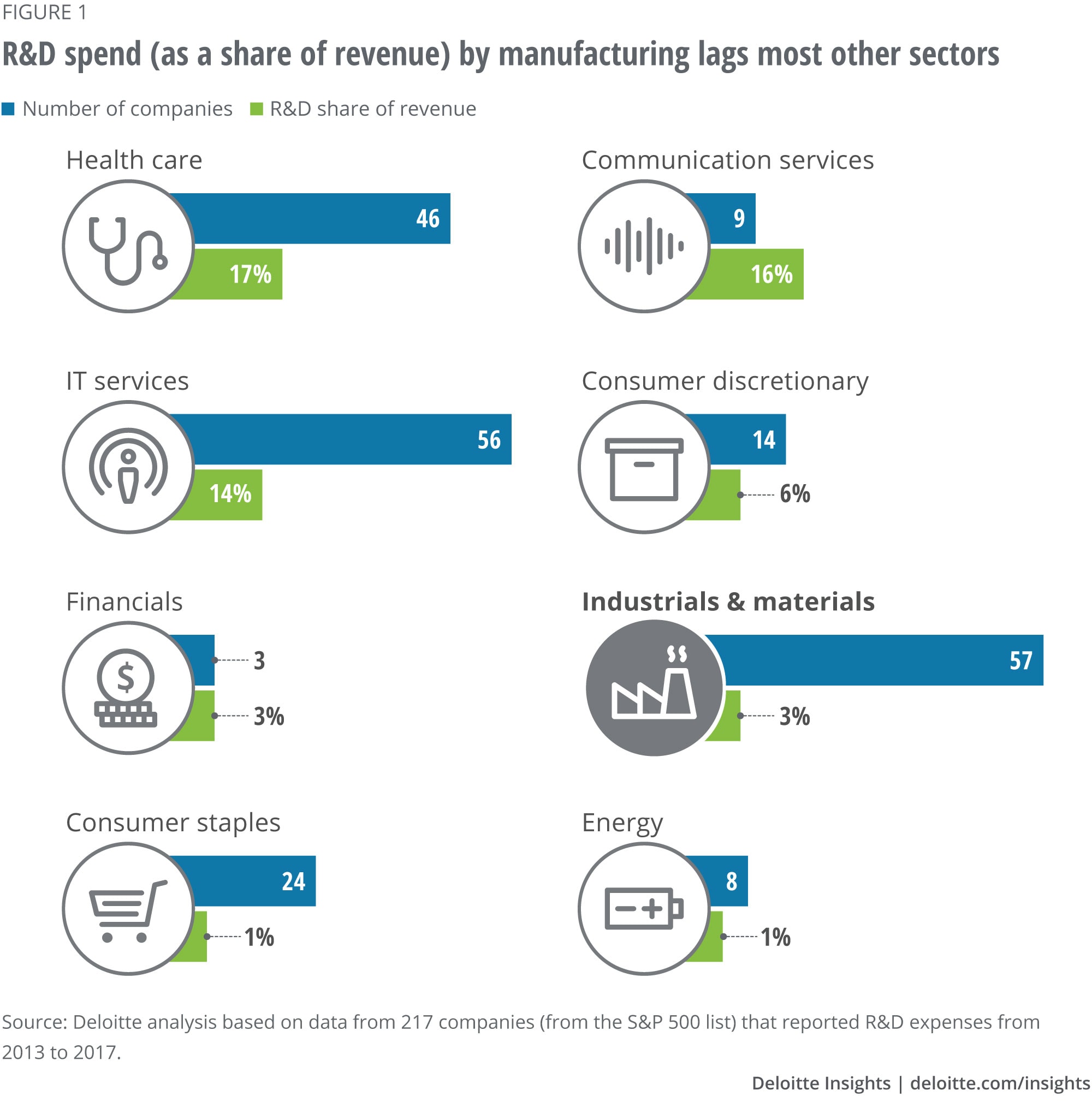
There are various types of innovation approaches that companies apply to create value for their businesses. Deloitte’s earlier research suggests that there are 10 types of innovations and 100 tactics to apply the 10 types to a business.5 The effectiveness of any innovation can be measured through the relation of inputs to outputs. Two outputs of innovation are new or improved processes and new or improved products, and thus the number of patents registered or granted can act as a proxy to measure innovation output. Measuring inputs, however, is far more complex. One of the markers is R&D expenditures. Our examination of the US patent universe revealed some notable patterns between R&D investments and patent output.
The pace of patent innovation is surging, but the intensity is plateauing
Patent-related innovation activity in the industrial manufacturing patent space has surged after the 2008 recession, indicating that manufacturers are indeed aiming to gain a competitive advantage through patent filings. The number of patents granted during 2009–2017 increased almost 8 percent per year (figure 2). In contrast, R&D investments posted a 3 percent annual increase, which could present a potential constraint for developing new patents.
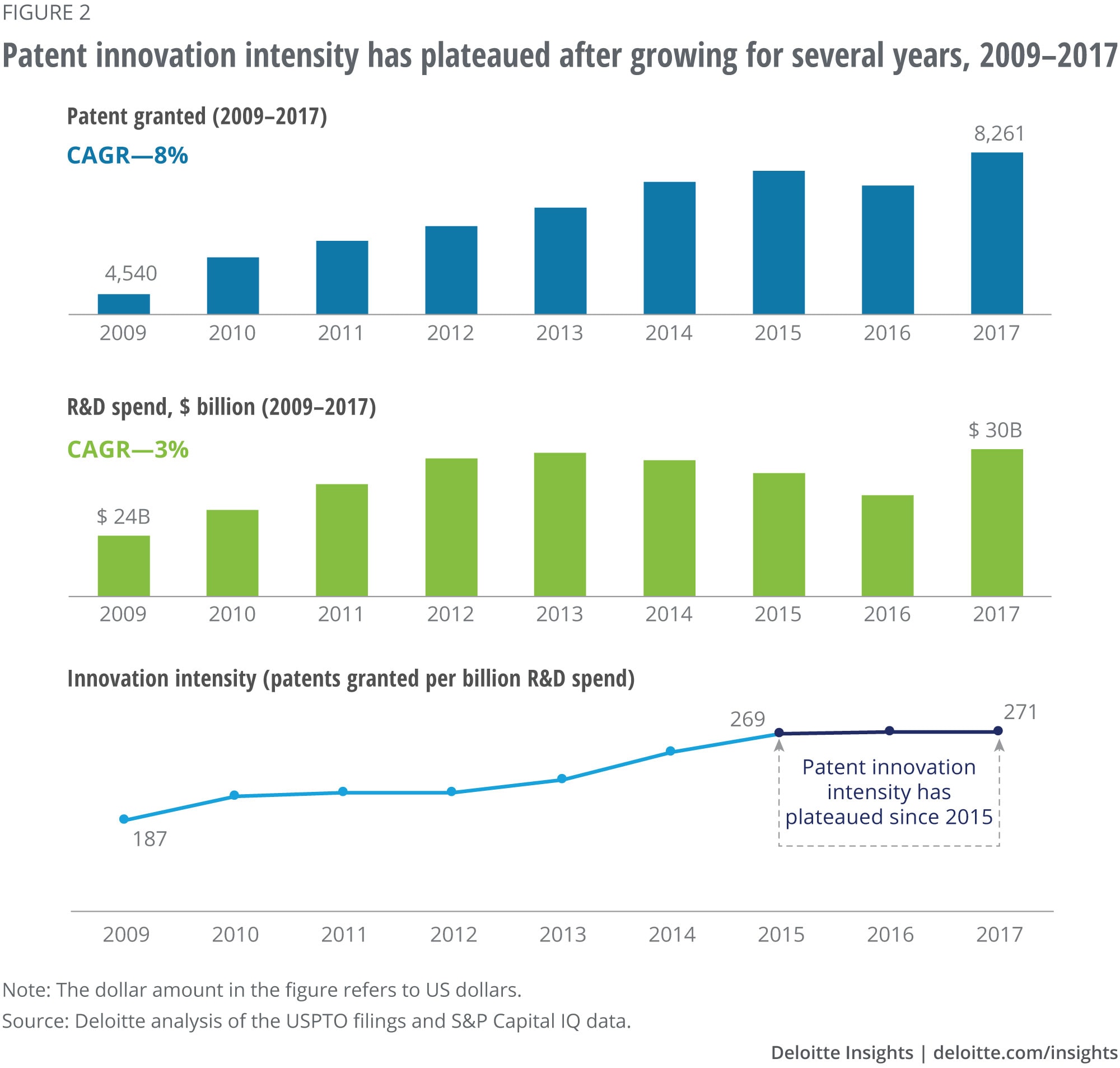
Over this same period of time, the patent innovation intensity (patents granted per billion dollars of R&D investment) saw a steady increase–until recently. Between 2009 and 2015, the patent innovation intensity in industrial manufacturing increased by more than 30 percent, from 187 patents per billion dollars in 2009 to 269 patents per billion dollars in 2015. Since 2015, however, it has all but plateaued. It would appear that industrial companies are spending more to gain new patents and, therefore, could be finding it more difficult to cost-effectively spur new inventions that lead to value creation for the business.
R&D expenditure and revenue are correlated, but decoupling could improve innovation intensity
Deloitte’s analysis of the annual revenue and R&D expenditures for industrial companies reveals a close relationship between the two, indicating that manufacturing executives are using annual sales as one of the yardsticks to determine R&D expenditure (figure 3). During 2009-2017, the correlation between revenue and R&D investment for the analyzed companies was 0.9–statistically a high correlation (a high correlation indicates a strong relationship between two variables). Here, it means that changes in revenues could account for over 90 percent of the changes in R&D investments.
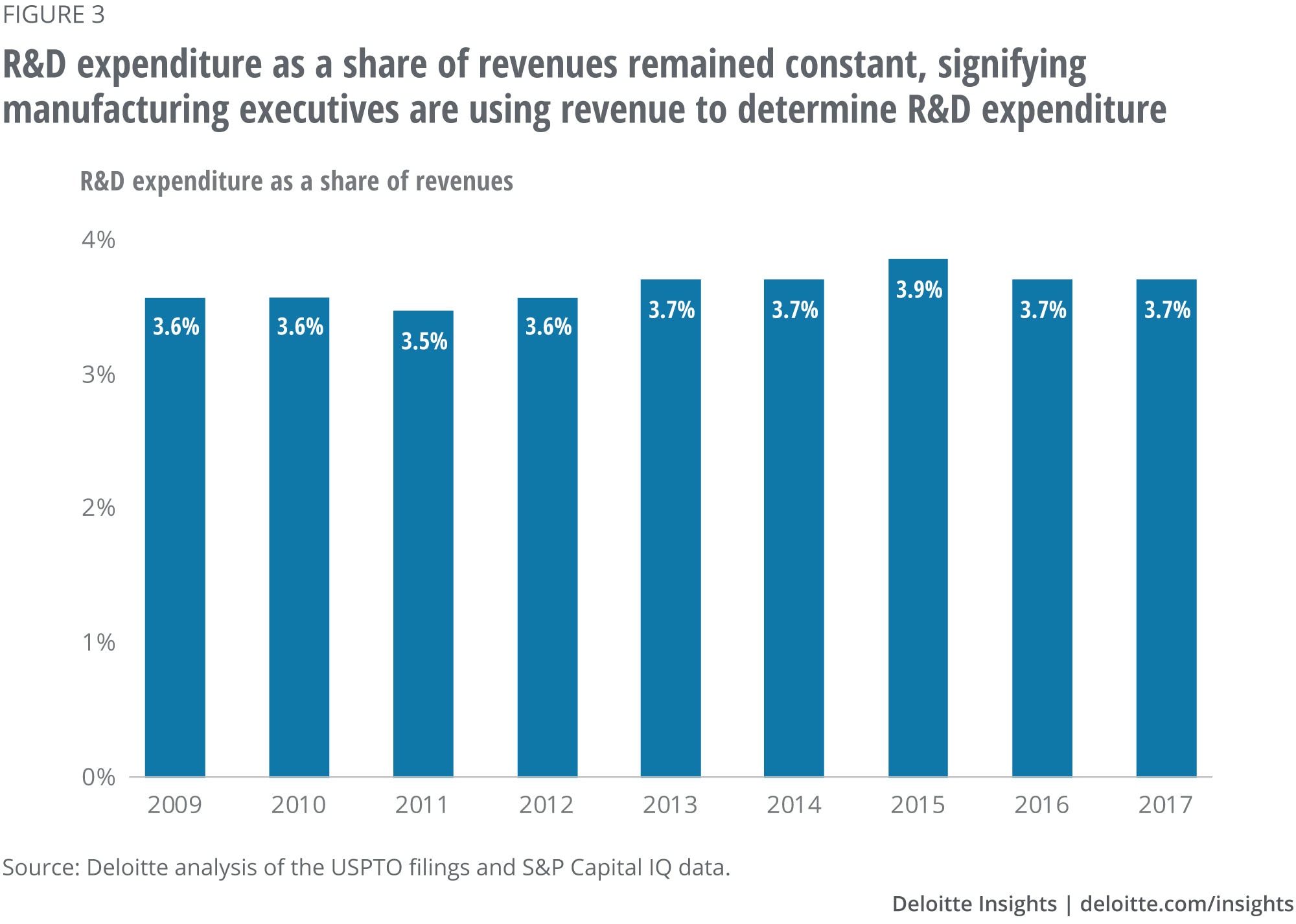
There is, however, possibly merit in changing this approach. Our analysis of the industrial patent filings throws up an interesting insight. Between 2009 and 2017, companies that were flexible with R&D investment and were maintaining or increasing the R&D dollar value irrespective of revenues registered over 2,100 patents (average patents per company), whereas those with a constant ratio registered less than 1,250 patents. In today’s competitive climate when R&D and innovation drive the most successful companies, a nimble approach to research spending could likely become a differentiating factor in a company’s success.
A winning approach: R&D dollars do not yield instant results. Industrial manufacturers may consider allocating dedicated financial resources for research, and then create a dynamic annual increase that mirrors the company’s growth strategy and long-term goal. As companies move further along the digital maturity curve, their investments may need to adjust (mostly upward) to achieve the intended strategic business outcomes, especially if disruption in the industry intensifies.
Caveat: Higher R&D expenditures do not always guarantee better patent innovation intensity
Despite the hazard of locking R&D expenditures to a percentage of revenue, blindly increasing R&D spend may not yield greater innovation output by itself. What might matter more is tying areas where R&D budgets are being spent more closely to the company’s long-term goals. Our analysis identified a “sweet spot” for patent intensity, and it is not the highest spenders. In fact, manufacturing companies with absolute R&D budgets between US$200 million and US$1 billion have the highest patent innovation intensity, even exceeding those with budgets of over US$1 billion (figure 4).
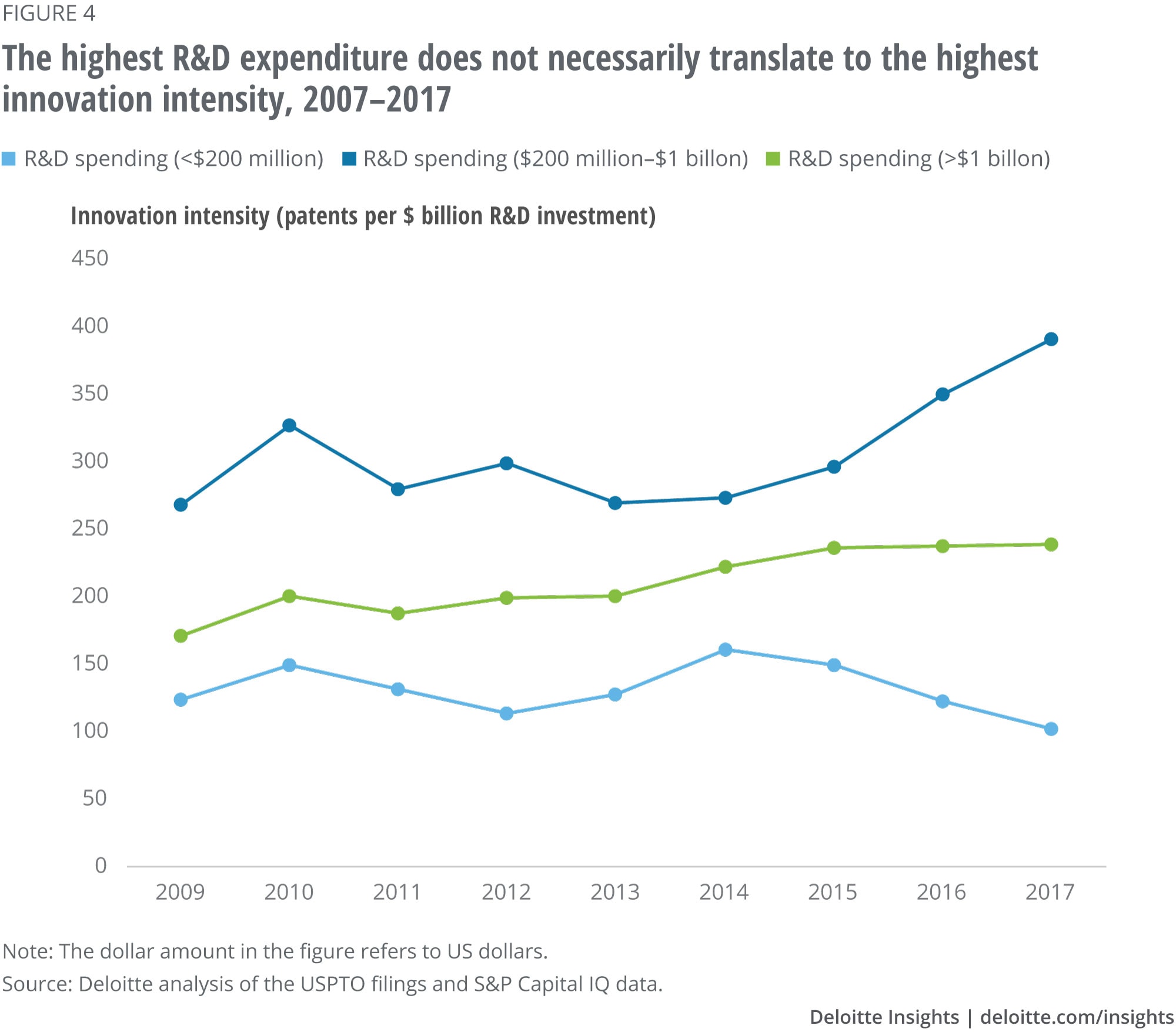
Additionally, we also observe that while the patent innovation intensity trend for high and low spenders shows volatility, the trend for companies with spend between US$200 million and US$1 billion seems much more stable (figure 4). This likely indicates that these companies are more consistent in their approach to patent research and seem to be leveraging their investments more strategically by identifying patent innovation areas that yield benefits in both the shorter and longer terms. A dual-term focus helps industrial companies ensure that not only are their R&D outputs providing value today but they also can lead to future related innovations.
A winning approach: More important than increasing R&D expenditure is often a focus on research efforts that align with business goals as well as short- and longer-term strategic growth objectives. Executives should consider focusing on targeted outcomes, which may manifest immediately or in the long term, that are well aligned with organizational goals.
R&D efforts enhance productivity through process innovation
Patent-based innovation can not only enhance products for customers, but also improve processes. Process-based innovations are considered more highly rewarding, albeit less explored, than the more common product- and customer-based innovations.6 Among the many direct benefits of process improvements are better production output and inventory optimization and hence reduced costs. For instance, process innovation to minimize material waste could result in fewer trips to locate and feed the material into the machine, thereby increasing productivity. Alternatively, innovation that automates material movement could yield labor savings. Such process innovations often go a long way in helping companies produce more with less, in turn enhancing efficiency and productivity of their employees. Our scan of the patent data shows a strong correlation (0.85) between employee productivity and patents (figure 5).
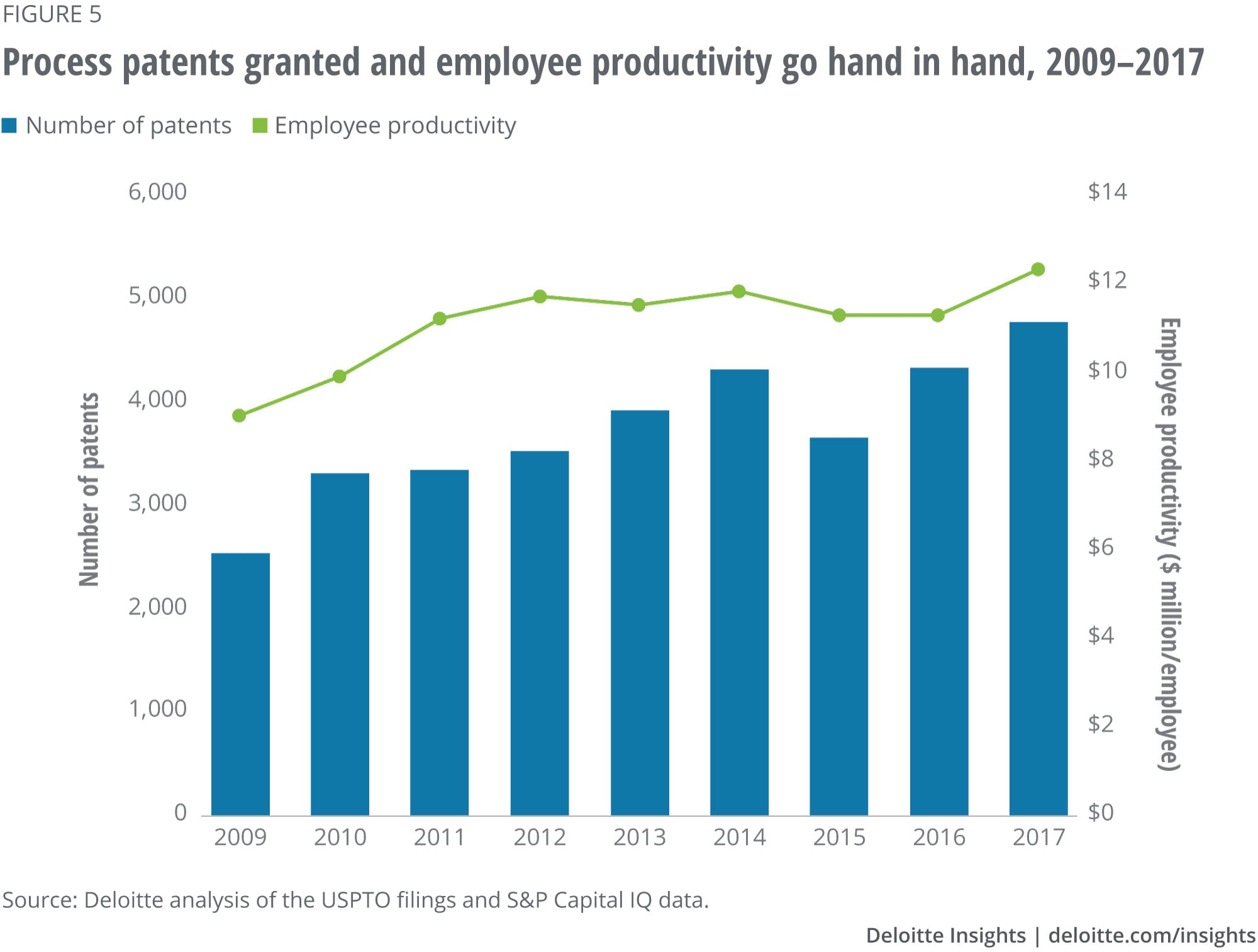
A winning approach: Manufacturing executives should consider focusing on supplementing product-focused R&D efforts with process-focused innovations that can yield additional results, including increased productivity, one of the key financial metrics for manufacturing performance. Beyond process-oriented innovations, industrial manufacturers can consider changing the profit model, business structure, or network plays that also yield business impacts.7
Next steps: Patent innovation is important to build future competitiveness
Innovation goes a long way on the road to corporate success—it is generally a measure of a company’s and a nation’s competitiveness,8 and also an input to financial performance. Deloitte analysis reveals patent-based innovation as a marker for how industrial companies are leveraging their financial resources for business impact. There are several approaches manufacturing leaders can adopt to help ensure their patent-based innovation investments yield returns.
They can decouple R&D expenditure from revenue, instead creating a dynamic annual increase that mirrors strategic growth objectives. This will likely lead to a sustainable R&D spend though business cycles and ensure an ongoing stream of innovation into the enterprise.
They should make targeted R&D investments tied to discrete business goals. Increasing R&D expenditure without aligning with business goals and longer-term strategic growth objectives will likely not yield greater patent-innovation intensity or business results.
They should look for patent-based innovation opportunities in processes, as such innovation may yield significant business results (improved efficiency and employee productivity, among others).
Patent-based innovation is only one type of innovation that many industrial companies are using to remain competitive, but it continues to be an important investment area and one that can deliver competitive differentiation.
Explore more
-
Innovation accelerators Article5 years ago
-
Cloud as innovation driver Article5 years ago
-
Special operations forces and great power competition Article5 years ago
-
Accelerating digital innovation inside and out Article5 years ago
-
What government can learn from venture capital Article5 years ago
-
What is work? Podcast5 years ago













